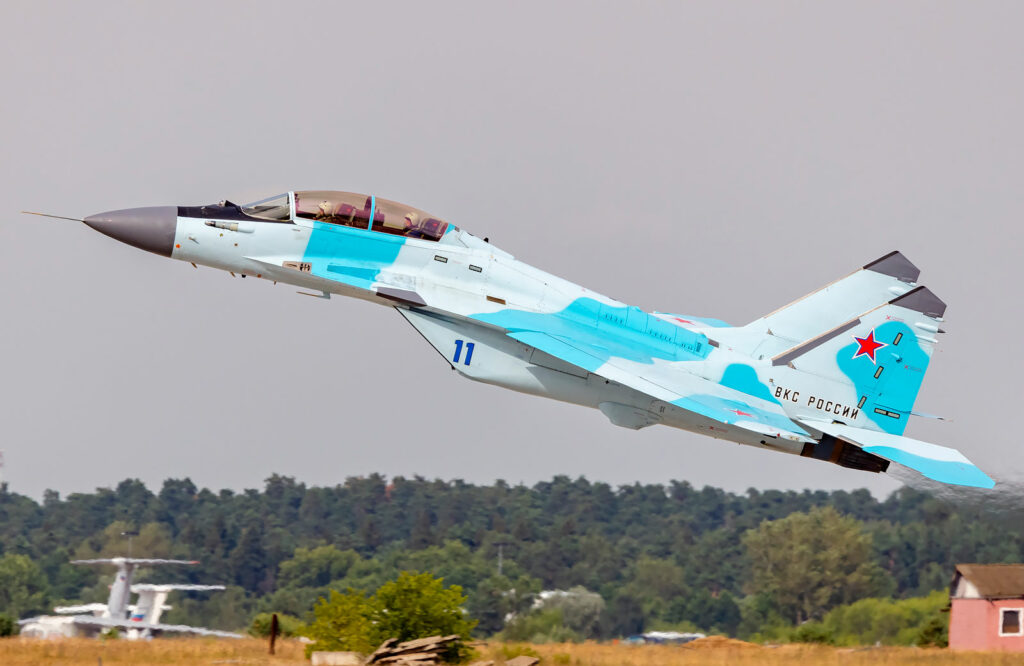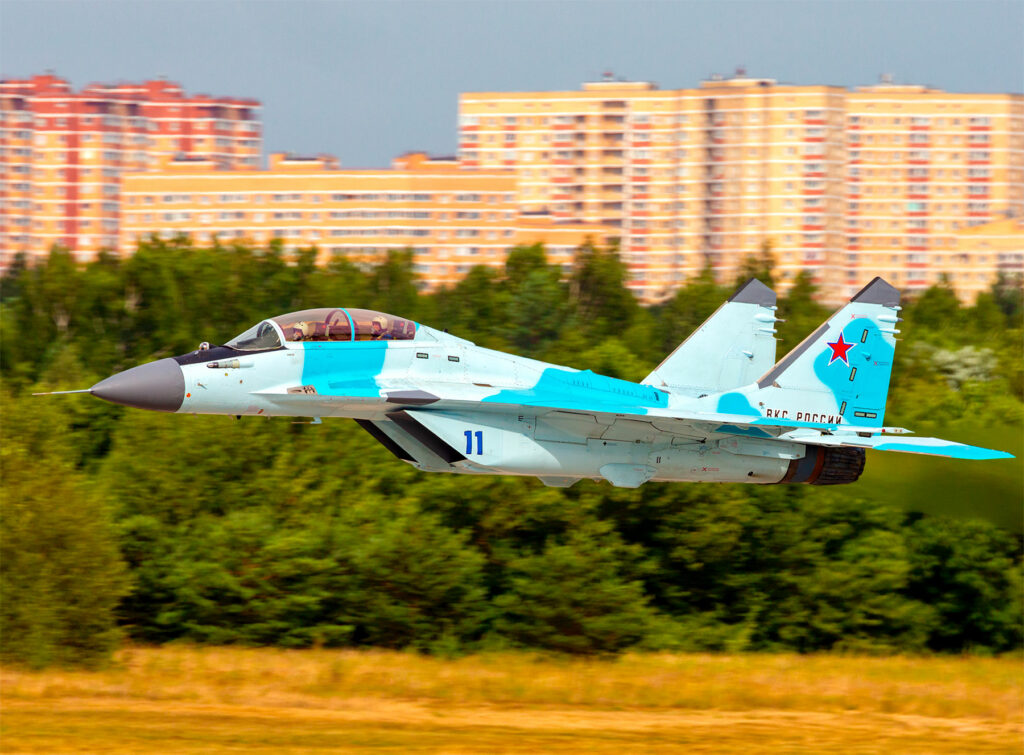The Mikoyan MiG-35 (Fulcrum-F) is a multi-role fighter with advanced avionics, enhanced survivability, and precision targeting capabilities.
The Mikoyan MiG-35 (Fulcrum-F) is a fourth-generation-plus multi-role fighter developed by Russia’s Mikoyan design bureau. Designed to perform air superiority and precision strike missions, it is an evolution of the MiG-29 platform, featuring significant advancements in avionics, weaponry, and survivability. Powered by two Klimov RD-33MK afterburning turbofan engines, the MiG-35 achieves a top speed of Mach 2.25 (2,400 km/h or 1,490 mph) and can operate at altitudes up to 17,500 meters (57,400 feet). Its range exceeds 2,000 kilometers (1,243 miles) with external fuel tanks.
The aircraft is equipped with an AESA radar, IRST (infrared search and track), and an advanced electronic warfare suite. It carries a diverse payload, including air-to-air and air-to-ground missiles, guided bombs, and a GSh-30-1 30mm cannon. First introduced in 2007, the MiG-35 continues to serve as a modernized and cost-effective solution for both domestic and export markets.
History of the development of the Mikoyan MiG-35 (Fulcrum-F)
The Mikoyan MiG-35 originated as a response to the changing demands of aerial warfare and the need for cost-effective yet capable multi-role fighters. During the late 1990s and early 2000s, the global military aviation landscape shifted towards aircraft that could fulfill multiple combat roles while incorporating advanced avionics and weaponry. This shift posed a challenge for Russia, whose existing fleet of MiG-29s was increasingly outdated.
The MiG-29, introduced in the 1980s, had proven its effectiveness as a lightweight, agile fighter. However, it lacked the range, payload, and avionics required to compete with modern Western fighters like the F-16 and Eurofighter Typhoon. Recognizing this gap, Mikoyan began developing an upgraded version of the MiG-29 to meet both domestic and export demands. The project aimed to create a fighter capable of excelling in air-to-air and air-to-ground roles while integrating advanced technologies.
The MiG-35 program was officially launched in the early 2000s. Building on the MiG-29M and MiG-29K variants, the new aircraft featured substantial upgrades, including a redesigned airframe, enhanced engines, and state-of-the-art avionics. The primary goals were to improve range, survivability, and multi-role flexibility while reducing operating costs. This effort aligned with Russia’s broader military modernization strategy, which emphasized developing affordable platforms that could also attract international customers.
The MiG-35 made its public debut at the Aero India exhibition in February 2007, showcasing its capabilities to potential export clients. The aircraft’s first flight occurred later that year, marking a significant milestone in its development. Despite its impressive features, the MiG-35 faced challenges in securing large-scale production orders, partly due to competition from other Russian fighters like the Su-30 and Su-35.
In 2017, the MiG-35 underwent further refinement, with the introduction of the production-standard variant featuring advanced radar, electronic warfare systems, and compatibility with a wider range of weapons. The aircraft’s NATO designation, Fulcrum-F, reflects its lineage as an evolution of the MiG-29 Fulcrum series. By incorporating lessons learned from earlier models, the MiG-35 offers a comprehensive solution for modern combat scenarios.
The Russian Air Force and Navy were among the initial operators of the MiG-35, primarily using it to replace older MiG-29 variants. The aircraft has also been marketed to international customers, emphasizing its cost-effectiveness, versatility, and advanced features. While it has not achieved the same export success as its predecessors, the MiG-35 remains a key component of Russia’s military aviation strategy.

Design of the Mikoyan MiG-35 (Fulcrum-F)
The Mikoyan MiG-35 features a refined design that enhances its performance, survivability, and versatility in combat. Building on the MiG-29 platform, the MiG-35 incorporates structural, aerodynamic, and technological advancements to meet modern operational requirements.
The airframe of the MiG-35 is constructed using lightweight composite materials and alloys, reducing its overall weight while improving durability. The aircraft measures 17.32 meters (56.8 feet) in length, has a wingspan of 12 meters (39.4 feet), and stands 4.73 meters (15.5 feet) tall. These dimensions provide an optimal balance of agility and stability.
The cockpit is equipped with a digital glass display system, including three multifunctional screens, a wide-angle head-up display (HUD), and HOTAS controls. These features improve situational awareness and pilot efficiency during high-intensity missions. The MiG-35 also includes an upgraded life-support system, ensuring pilot comfort and safety.
One of the aircraft’s most significant advancements is its Zhuk-AE AESA radar, capable of tracking multiple targets simultaneously. Complemented by an infrared search and track (IRST) system, the MiG-35 offers enhanced target detection and engagement capabilities in both air-to-air and air-to-ground scenarios. Its electronic warfare suite provides effective countermeasures against enemy radar and missile systems.
The propulsion system comprises two Klimov RD-33MK afterburning turbofan engines, each generating 9,000 kilograms (19,841 pounds) of thrust with afterburners. These engines include smokeless combustion chambers and improved corrosion resistance, making them suitable for various environmental conditions.
The MiG-35’s aerodynamic design includes leading-edge root extensions (LERX) and thrust-vectoring nozzles, enhancing maneuverability and stability during high-speed engagements. However, its reliance on twin engines increases maintenance requirements compared to single-engine competitors.
Performance of the Mikoyan MiG-35 (Fulcrum-F)
The Mikoyan MiG-35’s performance parameters position it as a competitive fourth-generation-plus fighter. Powered by two Klimov RD-33MK turbofan engines, the aircraft produces a combined thrust of 18,000 kilograms (39,683 pounds) with afterburners. This power enables the MiG-35 to achieve a maximum speed of Mach 2.25 (2,400 km/h or 1,490 mph) at high altitudes.
The aircraft’s operational range is approximately 2,000 kilometers (1,243 miles) with external fuel tanks, extending to 3,100 kilometers (1,926 miles) with aerial refueling. Its service ceiling of 17,500 meters (57,400 feet) provides a tactical advantage in air superiority missions. The MiG-35’s rate of climb is 330 meters per second (64,961 feet per minute), allowing it to respond quickly to threats.
The MiG-35 can carry up to 6,500 kilograms (14,330 pounds) of ordnance on nine hardpoints. Its weapon options include R-77 and R-73 air-to-air missiles, Kh-31 and Kh-29 air-to-surface missiles, KAB-500 laser-guided bombs, and unguided munitions. The aircraft is also equipped with a GSh-30-1 30mm cannon for close-range engagements.
Compared to competitors such as the F-16 Fighting Falcon and JAS 39 Gripen, the MiG-35 offers superior maneuverability and payload capacity. However, its twin-engine design results in higher operational costs. Despite this drawback, the MiG-35’s advanced avionics and multi-role flexibility make it a formidable contender in the global fighter market.
Variants of the Mikoyan MiG-35 (Fulcrum-F)
The Mikoyan MiG-35 exists in two primary variants: the MiG-35S single-seat configuration and the MiG-35UB two-seat trainer version. Both variants share the same core systems, including advanced avionics, propulsion, and weaponry. The MiG-35UB includes additional controls for the instructor, making it suitable for pilot training.
Potential future variants could include specialized configurations for electronic warfare or enhanced strike missions. Export models may also feature modifications to meet specific customer requirements, such as localized avionics or weapon compatibility.

Military use and combat of the Mikoyan MiG-35 (Fulcrum-F)
The Mikoyan MiG-35 is designed to perform a wide range of military missions, including air superiority, ground attack, and reconnaissance. Its advanced avionics and diverse weapon loadout enable it to operate effectively in both offensive and defensive roles. While the MiG-35 has not yet seen significant combat use, it continues to undergo evaluations and demonstrations for potential customers.
Armament includes a combination of air-to-air and air-to-surface missiles, guided bombs, and a 30mm cannon. This payload flexibility allows the MiG-35 to adapt to various mission profiles, from dogfighting to precision strikes. The aircraft’s electronic warfare suite enhances survivability by disrupting enemy radar and missile systems.
The Russian Air Force has adopted the MiG-35 to replace aging MiG-29s. Export opportunities include countries in Asia, Africa, and Latin America. While it competes with Western fighters like the F-16 and Rafale, the MiG-35 offers a cost-effective alternative with advanced features.
Back to the Fighter Jet section.